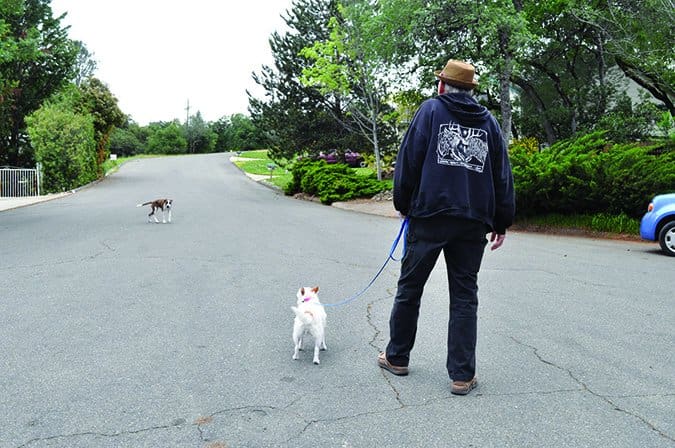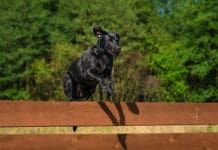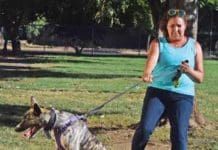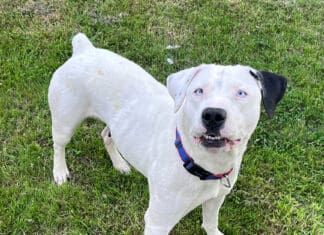[Updated October 12, 2017]
It’s the stuff of nightmares: You and your dog are enjoying a walk through the neighborhood when all of a sudden, you spot an unaccompanied canine rounding the corner and heading your way. It can turn into a bad scene even if you and your dog are both young, healthy, and your dog is confident and well socialized. But what if your or your dog is frail or fearful? What if you’ve spent months trying to rehabilitate a dog whose is extremely reactive to other dogs?

Being approached by loose dogs, especially when my dogs are on leash, is my least-favorite experience as a dog owner. When we’re walking in a public place, such as a beach or park, I can usually identify the owner and ask that he please wrangle his dog. Of course, this request may be met with varying responses, ranging from appropriately apologetic for their dog having invaded our space, to accusatory, suggesting I am the problem for not allowing my dogs to roam free and socialize. But as uncomfortable as it may be to deal with unpleasant dog owners, it can be even worse to deal with a loose dog whose owner is nowhere in sight!
While every situation is different, conducting an on-the-spot risk assessment and having a mental list of possible tactics can boost your confidence and help you make clear-headed decisions when every second counts.
Following are five non-assertive strategies that you can use to deal with loose dogs (or avoid them!) while on walks. As we all know, some situations call for more urgent actions. If a dog rushes at you or your dog, here are some alternative ways you can keep yourselves safe.
1. Avoid the Situation
As a dog trainer, I work to avoid avoidance in my canine students (since it’s a stress response), but I will happily work to avoid loose dog encounters. If I know there’s a certain house where the dogs are likely to be uncontained and free to rush toward, follow, or otherwise harass my dogs and myself, I pick another route for our walk.
Yes, it stinks that I have to change my behavior as a result of someone else’s inconsiderate habits, but my priority is the emotional and physical well-being of my dog and myself. At best, it’s unfair to ask my leashed dog to tolerate interaction with a loose dog – even a friendly one. At it’s worst, being ambushed by a loose dog can quickly spell disaster for dogs who are sensitive or reactive to dogs invading their personal space. And, of course, somewhere in the middle are the “we love everybody” dogs who would enthusiastically greet any dog, and whose enthusiasm quickly creates an excited frenzy that’s difficult for an owner to control. From a training perspective, the last thing we want to offer the overly social dog is the chance to go nose-to-nose with the loose dog – even when it’s a friendly dog – since that would be rewarding the over-excited behavior.
In general, leashes interfere with natural dog body language, especially when owners get nervous about the situation and without thinking or being aware of it, shorten (tighten) the leash. In this situation, the leashed dog is unable to use his natural language to effectively communicate with the approaching dog.
Dog body language is like a ballet of subtle and not-so-subtle behaviors that facilitate an exchange of valuable information. When held close to the owner on a shortened leash, a dog is unable to defuse an uncomfortable situation by changing positions relative to the intruding dog, or simply walking (or running) away.
Also, the sudden tightening of the leash easily becomes a red flag to your dog that you are uncomfortable, which can further stress both dogs. It is for this reason that trainers generally discourage on-leash greetings between dogs (even when both are willing participants in the interaction), or at least remind owners to maintain a loose leash during greetings where both parties have given consent.
If your immediate neighborhood offers limited options for re-routing a walk to avoid problematic areas, consider hopping in the car and driving to another neighborhood, or even to a local shopping center where it’s far less likely you’ll encounter other dogs. It may seem horribly inconvenient at first, but an ounce of prevention is worth a pound of cure – especially with dogs for whom encounters with loose dogs are especially challenging. It’s much easier to prevent significant behavior problems than to modify them later.
Depending on the situation, you can always visit the house where the loose dog is often seen (without your dog), and kindly ask the owners to contain their dog. If the dog is frequently running loose and you know where he lives, consider timing your visit for when you will likely encounter the dog, leash him up if possible, and knock on the owner’s front door. With this approach, it’s wise to point out how the loose dog is at risk for getting hit by a car or lost when he’s not properly contained, and you’d hate to see anything happen to him.
Although you’re likely to be annoyed, and the dog owners are in the wrong, as the saying goes, “kill them with kindness.” Find something to compliment about the dog, even if you’ve generally only see his less-than-desirable side. Something as simple as, “His coat is such a nice color,” or “I love his eyes” can often go a long way toward defusing the potential for confrontation and help maintain peaceful relations with neighbors.
Consider explaining that your dog is afraid of other dogs and it’s scary for her to have dogs run into her space, or that he’s “old and cranky” and you don’t want their (loose) dog to get snarked at by your dog. Yes, this approach can be a test of your emotional self-control since, if you’re like me, you’re likely to be supremely annoyed by the loose dog owners’ mind-blowing sense of entitlement. But remember the end goal is to encourage owners to contain their dogs, not to prove you are “right.”
If this fails, or past experience tells you it’s not a safe approach, there’s always the option of reporting a loose dog to animal control, or, if the dog can be safely handled, collecting the dog when he’s loose and unsupervised, and taking him to the local shelter. Some owners must experience some positive punishment before they are willing to change their behavior. (Note: In this case, “positive” is an operant conditioning term denoting the addition of something. In the case of “positive punishment,” what is added is unpleasant – having to visit the shelter to retrieve the dog, possibly pay a fine, etc.)
2. Pay Attention to Your Surroundings
The earlier you spot a loose dog, the easier it is to adjust your walk on the fly or prepare to manage a potentially sticky situation. I’m always shocked to see neighborhood dog owners walking dogs with leashes draped over their wrists and a coffee cup in hand, as they stare intently at their cell phones. All I can imagine is a loose dog rounding the corner, causing all heck to break loose in a very avoidable situation.
When you’re out with your dog, pay attention – especially if you know your dog doesn’t take kindly to interactions with unknown dogs, or if you worry about known loose dogs in the area.
If you do spot a loose dog, quickly changing direction is often an effective strategy, as many loose dogs are patrolling their perceived territory and aren’t likely to follow you all the way home. Stay calm as you instruct your dog to turn around with you, and remember to not choke up on the leash, as a tight leash is a glaring red flag to your own dog.
I typically walk with a favorite toy and/or treats and readily use one of these tools to capture my dog’s attention as I escort us out of the area. In that situation, I’d rather my dog not even notice the other dog, or if he does notice, I’d rather he not pay prolonged attention to the dog, since the more attention my dog pays to the loose dog, the more attractive we are likely to become.
The success of this U-turn approach depends largely on how readily your dog complies with your instructions. That’s a training issue. Never underestimate the importance of training.
In general, it might not seem like a big deal if your dog’s focus defaults to the environment and you find it hard to get his attention while on a walk, or if his loose leash walking is mostly acceptable, except when he sees other dogs, he gets super excited and starts pulling toward the dog. But when you find yourself in a sticky situation, not being able to get – and keep – your dog’s attention in the face of distractions can create unnecessary challenges.
3. Remain Calm and Try “Calming Signals.”
If you aren’t able to avoid an unwanted interaction with a loose dog, do your best to remain calm and use calm body language as a way to tell both dogs – yours and the intruder – that everything is fine, there’s no need for conflict.
Calming signals is a term coined by Norwegian dog trainer Turid Rugaas to describe a collection of behaviors dogs often exhibit when faced with stressful stimuli, including looking away to avoid eye contact, yawning, lip-licking, and sniffing the ground. Rugaas has postulated that these behaviors are used by dogs to communicate peaceful intentions and avoid potential conflict. Other behaviorists speculate that those behaviors are meant, in varying shades, to signal deference or avoidance – but the overall intent is to keep the dog who offers these behaviors safe and whole, not to “calm” the other.
We don’t know for certain what these signals mean, but most dogs understand them, so even humans can use them to help defuse a tense situation. The other dog won’t suddenly think you’re a dog just because you’re “speaking his language,” but the ability to communicate in a way he’s likely to understand can de-escalate an encounter that might otherwise turn into a confrontation, and can also help your own dog feel more relaxed during a challenging situation.
4. Body Block
My main goal when we encounter a loose dog on a walk, aside from ensuring our safety, is to prevent the loose dog from making contact with my dog. To help accomplish this, I will purposefully position myself between my dog and the incoming dog, asking my dog to sit and jockeying position as necessary to keep the approaching dog at bay.
Depending on my interpretation of the incoming dog’s intent, I might posture a bit, weight forward as I sternly tell the dog to “Go home!” or “Get back!” Sometimes asking a loose dog to “sit” in a firm voice helps stop the dog’s forward motion. From there, you can toss a handful of treats behind the dog and as he turns to eat them, you now have valuable time to move away.
In the face of a loose dog coming at you and your dog, Certified Applied Animal Behaviorist Patricia McConnell, PhD, suggests taking the tossing of a handful of treats one step further; she actually suggests throwing a handful of treats into the charging dog’s face. She admits it would not stop a “highly motivated, hard-charging dog who is laser focused on attacking you or your dog,” but she made a video and posted it on her blog to show that it can work. See tinyurl.com/grrftsf.
5. Other Alternatives
When it comes to managing encounters with loose dogs, there’s no one-size-fits-all solution. Following are some additional tactics to consider:
Deterrent Spray
We don’t recommend traditional mace or pepper spray, including those sold as animal deterrents, such as Halt! Dog Repellent (hot pepper-based), due to the potential risk of blow-back into your eyes or your dog’s eyes. (Even the faintest waft of mace or pepper spray can be extraordinarily painful.)
However, a citronella-based deterrent spray such as Spray Shield (formerly sold under the name “Direct Stop”) can help stop the unwanted advance of a dog, or, in extreme cases, can be used to help break up a dog fight, and is far less caustic in nature.
Air Horn
The sudden, loud blast of an air horn can often frighten a loose dog and cause him to turn-tail and head home. Pocket-sized air horns can be found in sporting good and marine stores. The downside to an air horn is that the noise can scare your own dog, too. If this is a tactic you’d consider using, it’s wise to desensitize your dog to the noise first.
Walking Stick
Many people carry a walking stick, golf club or other similar object that can be brandished as a weapon when faced with an unwanted approaching dog. The goal here, is to intimidate the dog in an effort to stop his approach, not to cause bodily harm. The crisp “crack!” of a stick slapping the ground, or the audible “whirl!” of a club slicing through the air will often deter an approaching dog without ever needing to make physical contact. Some people also report success using the sudden burst of an opened, push-button umbrella. With any of these tactics, be mindful of the potential for scaring your own dogs.
Head up a Walkway/Driveway
Heading toward a neighbor’s front door or up the driveway as though you live there often gives loose dogs second thoughts, as they can be leery of more confined spaces and of being captured.
Unconventional Exit Strategies
Depending on the size of your dog, objects in the environment can provide unique protection against approaching dogs. A client once told me her husband quickly jumped into the back of a parked pickup truck with their small terrier to avoid an aggressively approaching dog. The quick-thinking client of a fellow trainer once put her little dog in a trashcan to keep him safe as she dealt with the problematic loose dog. Lucky for them, it was trash day and the cans were out on the curb!
Whatever approach you choose, do your best to remain calm so as not to escalate the situation with your own panicked behavior. After any altercation with a loose dog, carefully assess your dog for injuries and consider taking him to the veterinarian, as bite wounds can be difficult to spot under thick fur. Write down as much as you can remember about the incident, such as location and a description of the dog, and contact your local animal control agency.
Stephanie Colman is a writer and dog trainer in Los Angeles.






Thank you for an option I had not thought of. I recently encountered a loose schar per coming towards me and my miniature schnauzer. I turned and walked in a different direction.